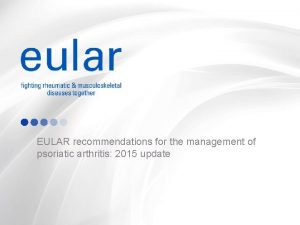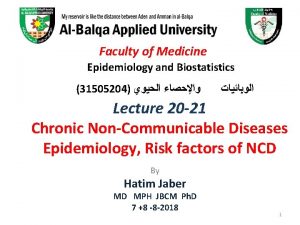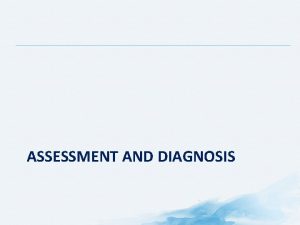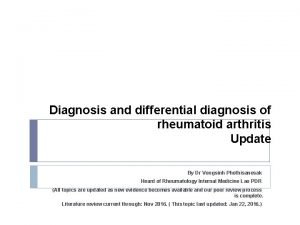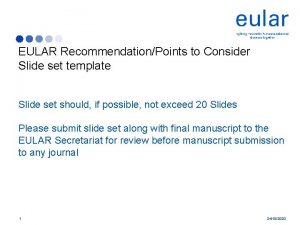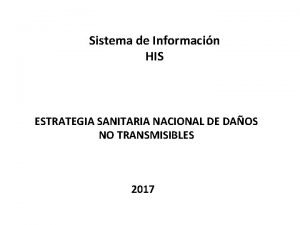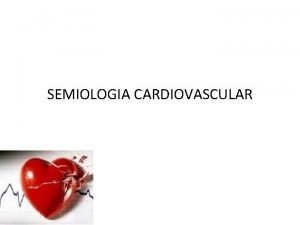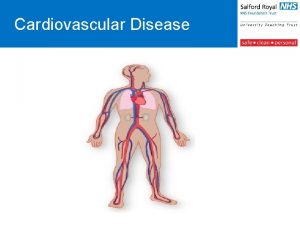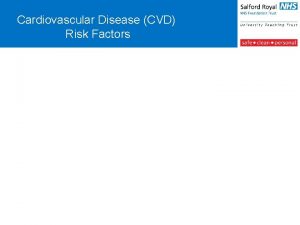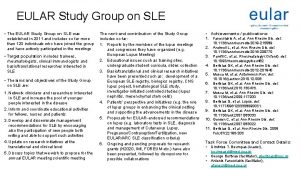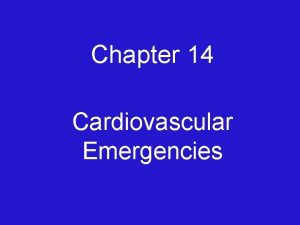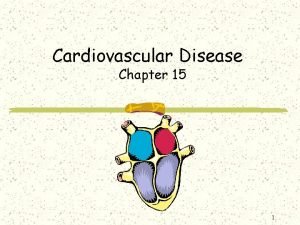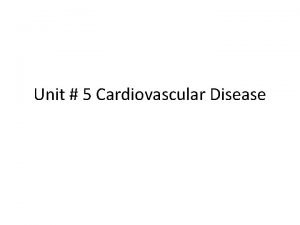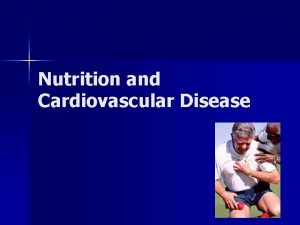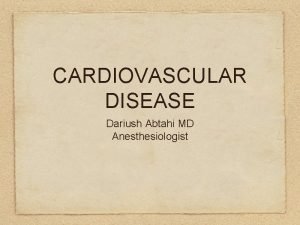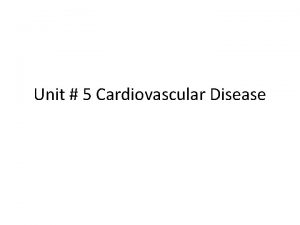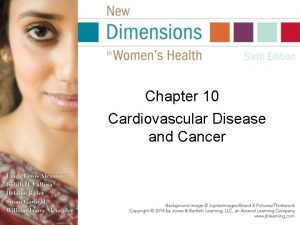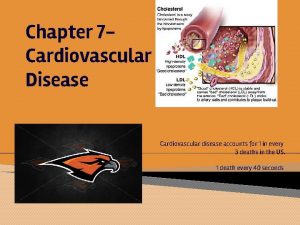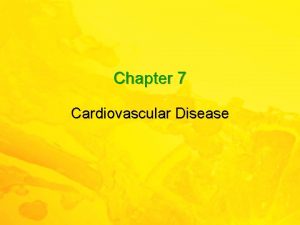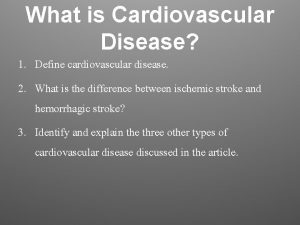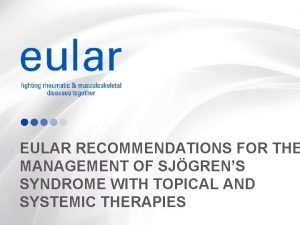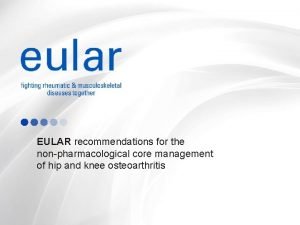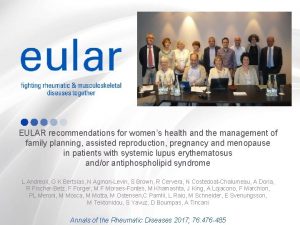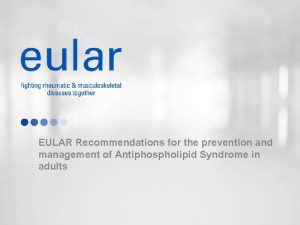EULAR recommendations for cardiovascular disease risk management in





















- Slides: 21

EULAR recommendations for cardiovascular disease risk management in patients with rheumatoid arthritis and other forms of inflammatory joint disorders: 2015/2016 update

Slide 1: Target population/question • Patients with inflammatory joint disorders, particularly rheumatoid arthritis, ankylosing spondylitis and psoriatic arthritis • To update the EULAR 2009 cardiovascular disease (CVD) risk management recommendations. 2 05/12/2020

Methods I • According to 2014 EULAR standardised operating procedures*: • Task force § • Systematic literature search § § • Research questions search terms Protocol according to the Preferred Reporting Items for Systematic Reviews and Meta -Analysis statement (http: //www. prisma-statement. org) Consensus finding meeting § § • 26 members from 13 European countries, including 2 patient representatives, 14 rheumatologists, 2 cardiologists, 3 internists, 1 healthcare professional and 4 fellows. 10 concept recommendations 10 new/updated recommendations Graded for methodological strength after the meeting Level of agreement (anonymous) § Through internet * van der Heijde D, Aletaha D, Carmona L, et al. 2014 Update of the EULAR standardised operating procedures for EULAR-endorsed recommendations. Ann Rheum Dis 2015; 74: 8– 13. 3 05/12/2020

Methods II 4 05/12/2020

Overarching prinicples • A. Clinicians should be aware of the higher risk for CVD in patients with RA compared with the general population. This may also apply to AS and Ps. A. • B. The rheumatologist is responsible for CVD risk management in patients with RA and other IJD. § Important to note the responsibility concerns that’s gets done, but not that this should be done by rheumatologists themselves • 5 C. The use of NSAIDs and corticosteroids should be in accordance with treatmentspecific recommendations from EULAR and ASAS. 05/12/2020

Recommendation 1 • Disease activity should be controlled optimally in order to lower CVD risk in all patients with RA, AS or Ps. A § Contribution of inflammation towards increased CV risk is less known in AS and Ps. A in comparison to RA § Lo. E: 2 B-3 6 05/12/2020

Recommendation 2 • CVD risk assessment is recommended for all patients with RA, AS or Ps. A at least once every 5 years and should be reconsidered following major changes in antirheumatic § Screening every 5 years is in line with ESC guidelines* § Lo. E: 3 -4 * Piepoli MF, Hoes AW, Agewall S, et al. 2016 European Guidelines on cardiovascular disease prevention in clinical practice: The Sixth Joint Task Force of the European Society of Cardiology and Other Societies on Cardiovascular Disease Prevention in Clinical Practice (constituted by representatives of 10 societies and by invited experts): developed with the special contribution of the European Association for Cardiovascular Prevention & Rehabilitation (EACPR). Eur Heart J 2016; 37: 2315– 81. 7 05/12/2020

Recommendation 3 • CVD risk estimation for patients with RA, AS or Ps. A should be performed according to national guidelines and the SCORE CVD risk prediction model should be used if no national guideline is available § Presently no validated disease specific CVD risk prediction models that accurately predict risk in RA are available § Lo. E: 3 -4 8 05/12/2020

Recommendation 4 • TC and HDLc should be used in CVD risk assessment in RA, AS and Ps. A and lipids should ideally be measured when disease activity is stable or in remission. Non-fasting lipids measurements are also perfectly acceptable § Patients with RA with active disease generally have lower serum TC and LDLc levels compared with the general population, while their CVD risk is elevated. § Measurement of TC and HDLc are perfectly acceptable in non-fasting state according to the 2016 European guidelines on CVD prevention* § Lo. E: 3 * Piepoli MF, Hoes AW, Agewall S, et al. 2016 European Guidelines on cardiovascular disease prevention in clinical practice: The Sixth Joint Task Force of the European Society of Cardiology and Other Societies on Cardiovascular Disease Prevention in Clinical Practice (constituted by representatives of 10 societies and by invited experts): developed with the special contribution of the European Association for Cardiovascular Prevention & Rehabilitation (EACPR). Eur Heart J 2016; 37: 2315– 81. 9 05/12/2020

Recommendation 5 • CVD risk prediction models should be adapted for patients with RA by a 1. 5 multiplication factor, if this is not already included in the model. § Based on all recent epidemiology, this multiplication factor is still the most evidence-based way of estimating CVD risk in patients with RA. § Lo. E: 3 -4 10 05/12/2020

Recommendation 6 • Screening for asymptomatic atherosclerotic plaques by use of carotid ultrasound may be considered as part of the CVD risk evaluation in patients with RA. § The presence of carotid plaques is associated with poor CVD-free survival and is strongly linked to future acute coronary syndrome (ACS) in patients with RA § The level of agreement of this recommendation by the task force members was low § Lo. E: 3 -4 11 05/12/2020

Recommendation 7 • Lifestyle recommendations should emphasize the benefits of a healthy diet, regular exercise and smoking cessation for all patients. § There is accumulating data that structured exercise therapy has beneficial CVD effects in patients with RA § In RA, the positive effect of a Mediterranean diet may be mediated by the effect of this diet on disease activity. However, there is no specific evidence available on the effect of dietary modifications on CVD risk in patients with IJD. Therefore, national guidelines regarding a healthy diet as part of a healthy lifestyle were recommended § Lo. E: 3 12 05/12/2020

Recommendation 8 • CVD risk management should be carried out according to national guidelines in RA, AS or Ps. A, antihypertensives and statins may be used as in the general population § For the management of hypertension and hyperlipidaemia, there is no evidence that treatment thresholds/targets should differ in patients with IJD compared with the general population. § Lo. E: 3 - 4 13 05/12/2020

Recommendation 9 • Prescription of NSAIDs in RA and Ps. A should be with caution, especially for patients with documented CVD or in the presence of CVD risk factors § There is evidence that NSAIDs might increase CVD risk in RA to a lesser extent in comparison to the general population than was previously thought. Hence, there is no evidence to be stricter with NSAID treatment in patients with RA than what is recommended for the general population § Lo. E: 2 a-3 14 05/12/2020

Recommendation 10 • Corticosteroids: for prolonged treatment, the glucocorticoid dosage should be kept to a minimum and a glucocorticoid taper should be attempted in case of remission or low disease activity; the reasons to continue glucocorticoid therapy should be regularly checked § Corticosteroids rapidly and effectively reduce inflammation in RA, but they have also been associated with an increased CVD risk, although the literature shows conflicting results. § There is no conclusive evidence about the long-term effects of corticosteroids, particularly in low daily dosage, on safety outcomes including CVD events in RA. § Lo. E: 3 -4 15 05/12/2020

Summary Table Oxford Level of Evidence 16 05/12/2020

Summary of Recommendations in bullet point format 17 05/12/2020

Summary of Recommendations in lay format I • One star (*) means it is a weak recommendation with limited evidence. • Two stars (**) means it is a weak recommendation with some evidence. • Three stars (***) means it is a strong recommendation with some evidence. • Four stars (****) means it is a strong recommendation with a lot of evidence. • Rheumatoid arthritis, ankylosing spondylitis or psoriatic arthritis should be controlled to lower the risk of cardiovascular disease. *** High disease activity leads to inflammation, which has been linked to cardiovascular disease. Controlling the disease and reducing inflammation will therefore reduce the risk of developing cardiovascular disease. • All patients should have a cardiovascular risk assessment at least once every 5 years and following major changes in treatment. ** Your doctor should perform a risk assessment for cardiovascular disease at least every 5 years, and whenever your medication is changed. This will give you an opportunity to get lifestyle advice and any preventative treatment you may need. If your cardiovascular risk is found to be high, then screening should be repeated more often. • Risk should be worked out according to national guidelines. A model called SCORE should be used if there are no national guidelines available. ** At present there are no disease-specific models recommended for people with rheumatoid arthritis, ankylosing spondylitis or psoriatic arthritis. Your cardiovascular risk should be worked out in the same way as for people without inflammatory joint disease. SCORE (Systematic Coronary Risk Evaluation) works out your risk of having a cardiovascular event over the next 10 years. 18 05/12/2020

Summary of Recommendations in lay format II • Cholesterol should be used to measure cardiovascular risk lipids, ideally when disease activity is stable or in remission. Non-fasting lipids measurements are also acceptable. ** Two types of cholesterol – called total cholesterol (or TC) and high-density lipoprotein cholesterol (or HDLc) – or non -fasting lipids are useful to assess cardiovascular risk. These can be measured with a blood test, preferably while your joint disease is stable or in remission. It is important that your doctor knows about your joint disease, since cholesterol results can be different in people with rheumatoid arthritis. • The results of risk prediction models should be multiplied by 1. 5 for people with rheumatoid arthritis. ** Models for predicting cardiovascular risk in normal people can underestimate the risk in people with rheumatoid arthritis, so the results should be multiplied. • Carotid ultrasound to screen for atherosclerosis and plaque deposits may be considered part of the cardiovascular risk assessment in people with rheumatoid arthritis. * Atherosclerosis is a condition where fat and debris build up in your arteries, causing them to harden and restricting the blood flow. Sometimes these may not cause any symptoms. If you have rheumatoid arthritis, your normal cardiovascular risk assessment could include ultrasound of your carotid arteries (in the side of your neck) to check for atherosclerosis and deposits. • Corticosteroids should be kept to a minimum and should be tapered for people in remission or low disease activity. ** Steroid medicines can increase cardiovascular risks if they are taken for a long time. If you need steroids, your doctor should give you the lowest possible effective dose for the shortest possible time. If you achieve remission of your disease, the steroid should be gradually withdrawn. 05/12/2020 19

Summary of Recommendations in lay format III • A healthy diet, regular exercise and stopping smoking are important. ** To reduce your cardiovascular risk, you should not smoke. A structured exercise plan and a healthy diet with less red meat and more fish, fruit and vegetables may also be beneficial for you. • How your cardiovascular risks are managed or treated depends on national guidelines for your joint disease; antihypertensive drugs or statins may be used normally. ** If you need drugs to manage your cardiovascular risk, you can be treated in the same way as someone without an inflammatory joint disease would be, unless the specific guidelines for your disease say otherwise. For example, antihypertensive drugs can be used help to lower blood pressure, or you may be prescribed a statin to reduce your cholesterol. • NSAIDs should be used with care in people with rheumatoid arthritis or psoriatic arthritis, especially in people who already have cardiovascular disease or are at risk of developing it. ** Some types of non-steroidal anti-inflammatory drugs (often called NSAIDs) can increase the risk of developing cardiovascular disease: Anaprox, Naprelan, Naprosyn, Aleve or Mediproxen (naproxen) can be used. • The following drugs should be avoided when there is established congestive heart failure, ischaemic eart disease, peripheral arterial disease or cerebrovascular disease: Voltaren, Cataflam, Cambia, Zipsor or Zorvolex (diclofenac), Advil, Medipren, Motrin, Nuprin, Neurofen (ibuprofen). 20 05/12/2020

Acknowledgements • 21 We thank Johannes C. F. Ket, MSc and Linda J. Schoonmade, MSc, Medical Information Specialists, Medical Library, VU University Amsterdam, for their contribution to the systematic literature searches. 05/12/2020
 Gossec
Gossec Cardiovascular disease risk factor
Cardiovascular disease risk factor Chapter 11 the cardiovascular system
Chapter 11 the cardiovascular system Eular
Eular Eular criteria for ra
Eular criteria for ra Eular
Eular Eular criteria for rheumatoid arthritis
Eular criteria for rheumatoid arthritis Eular criteria for ra
Eular criteria for ra Eular
Eular Credit risk market risk operational risk
Credit risk market risk operational risk Bharathi viswanathan
Bharathi viswanathan Fiduciary investment risk management association
Fiduciary investment risk management association Risk map risk management
Risk map risk management Capillary bed
Capillary bed Riesgo cardiovascular por perimetro abdominal
Riesgo cardiovascular por perimetro abdominal Semiologia aparato cardiovascular
Semiologia aparato cardiovascular What makes up the circulatory system
What makes up the circulatory system Rutas integrales de atencion en salud
Rutas integrales de atencion en salud Rat cardiovascular system simulation
Rat cardiovascular system simulation National cardiovascular partners
National cardiovascular partners Cardiovascular/lymphatic system it's totally tubular
Cardiovascular/lymphatic system it's totally tubular Heart rate during exercise
Heart rate during exercise
